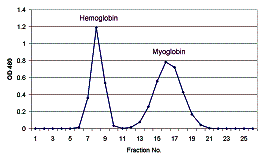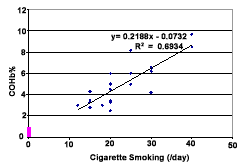

Carbon monoxide (CO) is the most commonly encountered and pervasive poison in our environment. It is a colorless, tasteless and odorless gas, released by incomplete combustion of carbonic fuels, which is responsible for more deaths than any other single poison. Its main environmental sources are emission from motor vehicles exhausts, passive and active smoking and fires, as well as from ammunition firing. Fighters in closed environments, tanks in particular, are especially vulenrable to CO toxification due to the relatively high levels released and the restricted ventilation.
As CO reacts very fast and at a very high affinity with heme-containing proteins, hemoglobin (Hb) in the blood, myoglobin (Mb) in the tissues and cytochromes and cytochrome oxidases in the mitochondria, it creates health hazards at all three levels of the respiration cycle, namely, oxygen transport to the tissues, oxygen take-up by the tissues and the oxidative utilization within the cells. A severe state of hypoxia is generated in the tissues upon exposure to relatively low concentrations of CO (tens and hundreds ppm). The myocardium which has high oxygen consumption is particularly vulnerable to the gas. Chronic exposure to even low doses of CO, environmental or occupational, results in high risk of coronary diseases as well as myocardium damage and heart iscemia.
The main goal of our research was to study the toxicity of inhaled CO both at the blood and at the tissue levels in an attempt to develop a predictive model for potential cardiovascular damage upon chronic and acute exposure to CO. Thus, we analyzed the levels of COHb, COMb and troponin as markers of the different responses to CO exposure. To achieve this goal we have developed a HPLC-based separation method between Hb and Mb in blood samples (Fig. 1). Troponin was analyzed by a specific ELISA method. The investigation was carried out with two populations: heavy smokers among the blood donors of the Belinson Hospital in Petach Tiqva and soldiers exposed to CO from tank firing. The results of these investigations were ambiguous. At the COHb blood levels we indeed found increases upon exposure to CO with the two groups. In particular, it was found that the levels of COHb increased upon exposure to CO. Moreover a linear correlation between smoking habits and blood CO was observed (Fig. 2).
 |
 |
| Fig. 1: Separation of Hemoglobin and Myoglobin by HPLC gel chromatography (G-75) – Calibration test. | Fig 2: Correlation between Smoking Habits (no. of cigarettes per day) and the blood level of COHb% (n=23). In purple: Non-smoking volunteers (n=7). |
Our results may indicate that there is no detectable damage to the cardiovascular system upon exposure to CO from either cigarette smoking (long-term effect) or gun fire (short term effect) that may be detected by the current methods. However, it may be that since we are looking for an accumulating effect over very long time intervals until the vascular damaged is shown, we are trying now to examine more sensitive markers e.g. CRP and IL6.